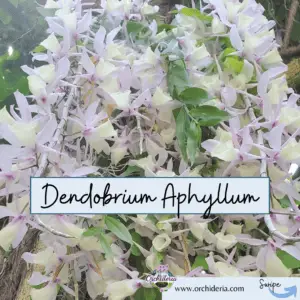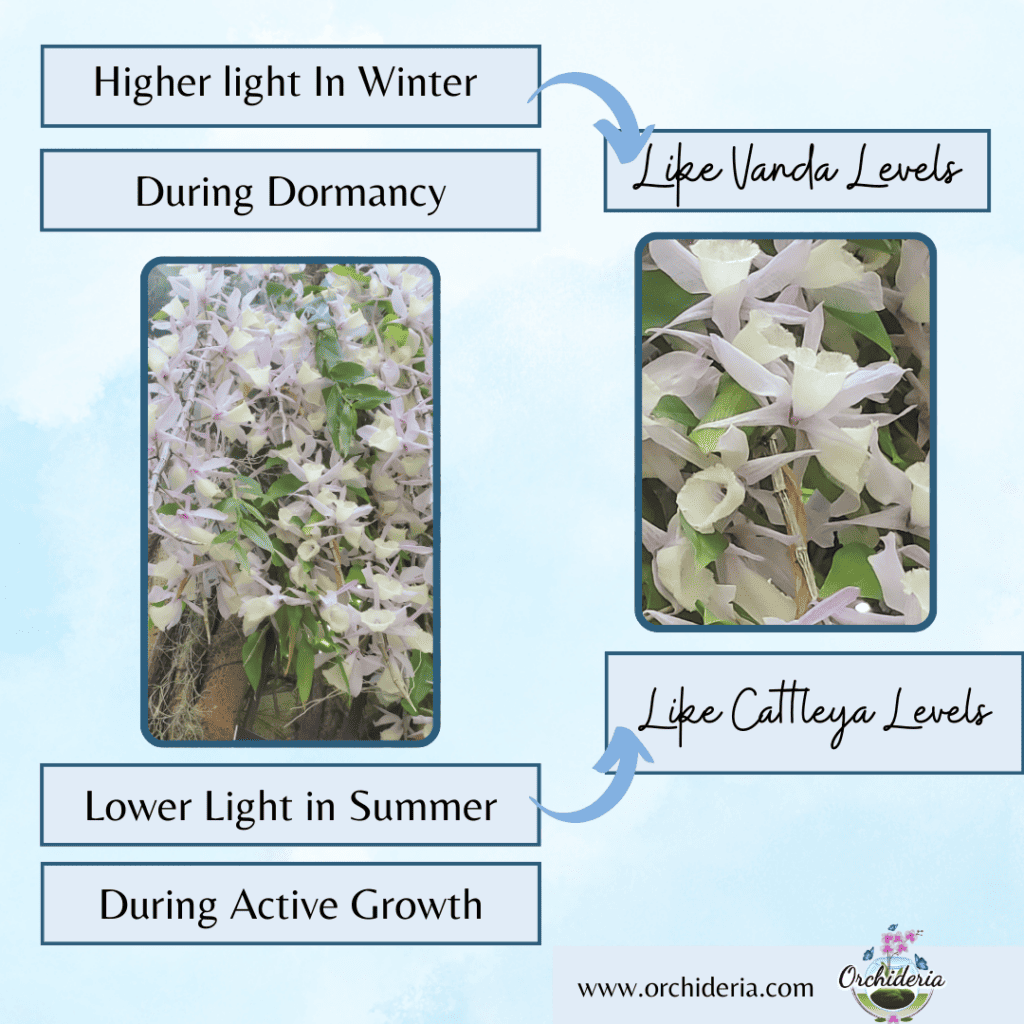Introduction
In this article you’ll learn how to care for Dendrobium aphyllum orchids, with various tips,detailed instructions, and seasonal guides. I write theses guides for beginners, since I am learning so much myself.
When I started off, I had such a hard time finding information that I could actually understand and follow, and that’s why I decided to write the care guide myself. Here are the basic, quick tips for a quick search about Dendrobium aphyllum orchids, but I will go into much more detail below on each topic:
- Sun Exposure Bright, indirect light (2000-3000fc)
- Temperature Warm to intermediate (60-85°F or 15-29°C)
- Humidity High humidity (40-70%)
- Watering Regular watering, allowing the top inch of soil to dry
- Fertilizer 30-10-10 orchid fertilizer every 2 weeks during active growth
- Soil Well-draining orchid mix, better mounted
- Hardiness Zones 10 to 11
- Lifespan Perennial
- Dormancy? yes
If you have been growing orchids for some time, that quick information above might be all you need, but I never found it to be enough. So, grab a cup of tea, get in a comfortable chair and let’s learn about this amazing orchid!

Fascinating Tips about Denddrium Aphyllum and Quick history
Dendrobium aphyllum fascinates me because of the two very distinct cycles it goes through each year.
In one, its this beautiful, flowing pendant orchid with literally hundreds of soft pink speckled with lavender and white flowers, that surely makes a statement. During the other part of the year, it’s this darn ugly orchid, that I want to hide when company comes over. The long, slender, leafless canes look like fermented spaghetti that I forgot to throw away.
I guess that Dendrobium aphyllum orchids are teaching me that life is kind of like that too… Some phases in life are dark; I don’t grow, nor evolve… I just sit there, looking helpless and wanting to give up. Then, out of the blue, a little growth appears, and suddenly, blam! I’m in such a state of splendid growth and splendor that it’s hard to even remember where I was emotionally (or physically, mentally, spiritually… add the term you’d like here). That’s one quick lesson I learned from orchid growing… Just give yourself time.
Anyway, back to the care guide for Dendrobium aphyllum. These Dendrobiums, also known as Dendrobium pierardii or cucullatum, are a popular orchid found in many collections. It is often referred to as the ‘hooded orchid’ due to the cone-shaped lip of its flower. In Brazil, they call it the stork-orchid.
One of the unique characteristics of Dendrobium aphyllum is its long, pendulous stems that become leafless during the resting period and for a few weeks in the spring.
During its blooming season, it produces numerous fragrant flowers in shades of pinkish violet, with a pale lilac or whitish lip. While there are many other visually stunning species within the Dendrobium genus, few are as rewarding and persistent in cultivation as Dendrobium aphyllum.
The species was initially discovered by William Roxburgh in southern India and described in his book “Plants of the Coast of Coromandel” in 1795. Throughout the nineteenth and twentieth centuries, it was commonly known as Dendrobium pierardi, possibly because of the detailed illustrations by Sir William Hooker in 1822.
This plant, also found in the Brazilian plains, was introduced in portuguese literature and described in 1845 by the Brazilian botanist Ignatz Urban, who was fascinated by its beauty and diverse colors. The species was named in honor of the French naturalist Charles Alexandre Lesueur. However, the correct name for this species is Dendrobium aphyllum, which came into general use after 1985 when Danish botanist Gunnar Seidenfaden confirmed its identity.
Comon Names For Dendrobium Aphyllum
“The name Dendrobium aphyllum refers to some of the unique characteristics of this orchid species. “Dendrobium” comes from the Greek word “dendron,” which means tree, and “bios,” which means life.
This name reflects the species’ epiphytic nature. “Aphyllum” comes from the Greek word “a,” which means without, and “phyllon,” which means leaf. In some parts of the world, this orchid is classified as the leafless orchid.
This refers to the fact that the leaves of Dendrobium aphyllum are reduced or absent, and it mainly relies on its pseudobulbs for photosynthesis.” (Source)
These names reflect the various regions and cultures where this orchid species is found and cultivated.
Several synonyms are known for this species such as:
- Limodorum aphyllum Roxb. (1795),
- (Basionym) Cymbidium aphyllum (Roxb.) Sw. (1799),
- Epidendrum aphyllum (Roxb.) Poir. (1810),
- Dendrobium cucullatum R.Br. (1821),
- Dendrobium pierardii Roxb. ex Hook. (1822),
- Dendrobium macrostachyum Lindl. (1830),
- Dendrobium tetrodon Rchb.f. ex Lindl. (1859),
- Dendrobium stuartii F.M.Bailey (1884),
- Dendrobium pierardii var. cucullatum (R.Br.) Hook.f. (1890),
- Callista aphylla (Roxb.) Kuntze (1891),
- Callista macrostachya (Lindl.) Kuntze (1891),
- Callista stuartii (F.M.Bailey) Kuntze, (1891),
- Callista tetrodon (Rchb.f. ex Lindl.) Kuntze (1891),
- Dendrobium gamblei King & Pantl. (1897),
- Dendrobium viridicatum Ridl. (1899),
- Dendrobium tetrodon var. vanvuurenii J.J.Sm. (1920),
- Dendrobium whiteanum T.E.Hunt (1951),
- Dendrobium madrasense A.D.Hawkes (1963),
- Dendrobium aphyllum var. cucullatum (R.Br.) P.K.Sarkar (1984),
- Dendrobium aphyllum var. katakianum I.Barua (2001).
The use of different common names for Dendrobium aphyllum can be attributed to its widespread distribution across different countries and continents. Each name represents the local or regional identification of this orchid species, highlighting its popularity and adaptability in various climates. (Source)
Dendrobium pierardii, for example, is a common name that was historically associated with this orchid. It may have originated from the detailed illustrations by Sir William Hooker in 1822, which led to its misidentification as Dendrobium pierardi. However, the correct name for this species is Dendrobium aphyllum, as confirmed by Danish botanist Gunnar Seidenfaden in 1985.
Regardless of the name used, Dendrobium aphyllum remains a beloved and widely cultivated orchid species. Its beauty, ease of care, and historical significance make it a favorite worldwide. Whether you refer to it as Dendrobium pierardii, Limodorum aphyllum, or any other common name, this orchid continues to captivate with its stunning flowers and graceful presence.
Natural Habitat for Dendrobium Aphyllum ( In Situ)
The natural habitat of Dendrobium aphyllum, also known as Dendrobium pierardii, spans a wide distribution across various countries and continents. From southern, central, and northeastern India to Nepal, Bhutan, Burma, China, Thailand, Laos, Cambodia, Vietnam, Australia, Borneo and Peninsular Malaysia, the Himalayas, this orchid species thrives in diverse environments.
It can be found growing in forests at elevations ranging from 100 to 1,600 meters, as well as on limestone cliffs, evergreen lowland forests. As you can see, these growing conditions are quite varied, meaning that the Dendrobium aphyllum can grow anywhere from hot to cool growing conditions.
These locations offer different climates and conditions for the growth and cultivation of this orchid species. which makes the cultivation of Dendrobium aphyllum easier to adapt to a wider range of climates.
In their natural habitat, Dendrobium aphyllum orchids experience mild to warm daytime temperatures (60-85°F or 15-29°C) during spring and summer, while the winter months bring cooler temperatures. The winter night temperatures typically range from about 41-53°F or 5-12°C. During the growing season, the temperatures are intermediate to warm, and the plants can tolerate high temperatures in the 95°F or 35°C range.

What is the Dormant Period for Dendrobium Aphyllum?
Dendrobium aphyllum need a winter break, or a resting period, where they will go dormant. It is common for Dendrobium aphyllum orchids to drop all or most of their leaves during the winter resting period.
During this time, the tips of the canes will not only drop but also stop producing new leaves, indicating that the plant has finished growing for the season. Gradually reduce watering and allow the plant to dry somewhat between watering.
During the dormant period for Dendrobium aphyllum orchids,which is the end of autumn going into early winter, the leaves will fall off your Dendrobium aphyllum orchid. It will turn into the ugliest little plant you have ever seen (sorry if that is blunt, but it’s true).
What will be left are the long slender canes, that should NOT be cut off. You can remove the spent flower spikes, but not the canes. Giving your Dendrobium a rest period is crucial for triggering blooming, and it can make a significant difference in the abundance and quality of flowers.
To simulate the conditions found in their natural habitats, it is recommended to stop watering the orchids around the beginning of December (if that is winter where you live). It is important not to resume watering until the buds have fully formed in the spring. If you live in an incredibly dry climate, you can mist the top of the pot a few times during this period, but do not water the orchid. It will be fine; trust me.
For some odd reason. (and I’m still looking into the why of this… I read once that it’s because the pseudobulbs are the ones photosynthesizing during dormancy, so they need the light, but since it was only one author, I’m waiting to see if another author agrees) Dendrobium aphyllum orchids like to be exposed to brighter light during their dormancy period. This means that you shouldn’t hide it under the bench like other dormant orchids. The pseudobulbs are not dead, just sleeping and the canes still react (somewhat to the higher Vanda-like light levels). Once they start producing leaves, then you can lower the light levels back to what a Cattleya would prefer. Do not place them in full sun.
Although there is some moisture in the habitat during the dormant period, the orchids don’t require a light watering every few weeks. This mimics the dew or fog that provides some moisture in their natural environment.
Growth will resume in early spring, around the same time that the flower buds begin to form. Once the buds have formed and new growth appears, increase watering again. Flower buds will appear on the stem opposite the attachment points of the leaves, and new growth will emerge from the base of the previous year’s growth.
Fertilizer Requirements for Dendrobium aphyllm orchids
I’d love to say to use the same balanced fertilizer all year round, like a 20-20-20 and apply every other week, but Dendrobiums aphyllum need more than that to thrive. So throw that idea away, and let’s get specific. To ensure optimal growth and blooming of Dendrobium aphyllum orchids, it is important to follow a specific fertilizer regime.
During the germination stage, it is recommended not to apply fertilizer as the plant absorbs nutrients from the old stem to produce new sprouts. This helps prevent the young seedlings from rotting.
Once the plant has developed new roots, fertilizer can be applied from April to October. A recommended fertilizer formula is 30-10-10 + TE (TE means trace elements), with a dosage of 1g per 4 liters of water. It is important to spray the fertilizer on both sides of the leaves. This high nitrogen dose fertilizer will give the Dendrobium orchid a boost in producing new leaves.
In August, it is advisable to switch to a different fertilizer formula, such as 6-30-30 + TE, using the same dosage. It doesn’t have to be specifically a 6-30-30, but any fertilizer with the last 2 digits (Potassium and Phosphorous) higher that the first number (Nitrogen). This helps promote flower bud development.
When the flower buds are visible at the top, it is recommended to use a fertilizer formula of 20-20-20 + TE to further support blooming. Don’t spray the flowers or get the blooms wet. Only apply the fertilizer to the leaves and roots.
However, during the dormant period from October onward, it is crucial not to fertilize the plants. Instead, allow them to remain under natural conditions. This period of rest is important for the orchids’ overall health and future blooming.
In addition to fertilization, it is also important to periodically spray a mixture of any fungicide control you have, be that Physan 20 or another light bactericide, every 15 days to prevent orchid diseases. However, during the extreme conditions from October to March of the following year, halt the frequency of preventive spraying due to the relatively lower disease risk.
As you can see, Dedrobium aphyllum orchids are high maintenance orchids and “unforgetaable” when they are awake, but when the sleep, there are “forgettable”. Except this high maintenance is good practice for all your orchids, and the beautiful blooms are well worth it.

Potting Mix and Substrate for Dendobrium apyllum Orchids
When it comes to choosing the right potting mix and substrate for Dendrobium aphyllum orchids, it’s important to consider their unique growth habits. These orchids have pendent stems, which can make them a challenge to grow in pots. As a result, they are often grown mounted or in hanging baskets.
If you choose to mount your Dendrobium aphyllum orchids, it’s important to use a sturdy mount material such as a cork slab or dense tree fern plaque. This will provide the necessary support for the larger species, which can grow to great size. Also, mounted plants can be watered daily in the summer, as long as there is good air circulation.
Alternatively, you can choose to grow your orchids in hanging baskets. In this case, it’s crucial to use a very well-drained epiphyte mix as the substrate. This will ensure that excess water can easily drain away, preventing the roots from becoming waterlogged.
To do this, you can use a medium consisting of coco chips, charcoal, and broken brick pieces. This mixture provides good drainage and aeration for the roots. However, it’s worth noting again that these orchids are likely to do better when mounted or grown in baskets.
Don’t Stop Learning!
If you want to be included in more information and get a 14-page fertilization guide, please sign up for my newsletter. I don’t spam, but send emails out bi-monthly with some curious topics of interest. If you want more information, click here to go to a specific page on this website where I explain it more in detail.

Also, if you are looking for an orchid journal to keep your notes specifically about orchid care, check out my 2 solutions for that on this page. If note-keeping isn’t your thing, then there is a free excel spreadsheet that you can download. Click here for more information on how to do that.
If you subscribe to my newsletter, I will send you a 14-page guide on the main tips of orchid fertilizer. It is downloadable and you can print it out on your computer. I designed the guide to double up as a coloring book, just to make it fun.
Is Dendrobium apphyllum Facing Extinction?
The Dendrobium aphyllum, also known as the Cerrado Orchid, is a native species of Brazil, endemic to the Cerrado region in Brazil. Brasilia, the capital of Brazil, is located in the Cerrado.
Scientific studies conducted by Silva et al. (2012) indicate that this orchid is extremely resilient and adaptable to adverse climatic conditions, being found in both the hottest and coldest Brazilian states, like where I live now.
According to the book “Orchids: A Systematic Approach” by Gomes (2005), the stem of this orchid is short and branched, making it easily cultivable in home gardens across the country. Additionally, it has been used for medicinal purposes in traditional Brazilian medicine, mainly for stomach ulcers and to relieve gastrointestinal discomfort.
The Dendrobium aphyllum is considered an endangered species in Brazil due to the loss of natural habitats caused by urban and rural expansion in Brazil. This is the part that breaks my heat…
Therefore, efforts are needed to preserve this species and ensure its survival in the near future. The conservation of this orchid is crucial to maintain the biodiversity of the Cerrado and protect its unique beauty for generations to come. Awareness is fundamental to keeping orchids in nature and only buying them from respected orchid growers. (Source)
Watering Dendrobium aphyllum Orchids
During the late spring, summer, and early fall, when these orchids are actively growing, it is important to provide them with regular watering. In their natural conditions, rainfall is heavy during these months, creating a fairly wet environment. In their natural habitat, this is when the heavy rainfall pours down almost daily, but quickly dries off.
For mounted plants in hanging wood baskets, daily watering is recommended as long as there is good air circulation. This helps to maintain the necessary moisture levels without causing waterlogged roots. However, it is important to note that the frequency of watering may vary depending on the specific conditions of your growing environment. If you live in a more humid environment, then water a bit more spaced out.
During the growing season, when new leafy stems emerge and mature, it is crucial to keep the plant well watered in a humid atmosphere. This can be achieved by misting the leaves regularly or having a humidifier or fogger in the same room.
In contrast, as the late fall approaches and winter sets in, the watering frequency should be reduced, then cut off completely. These months are typically drier in the natural habitat of Dendrobium aphyllum orchids. It is important to allow the plant to experience a slight dry period during this time to mimic its natural dormant period.
In all, I hope this care guide helped! If you aren’t sure that Dendroboum aphyllum is for you, then check out these other articles about Dendrobiums.
Thanks for reading and if it did help in any way, please leave a comment below. Thanks!

